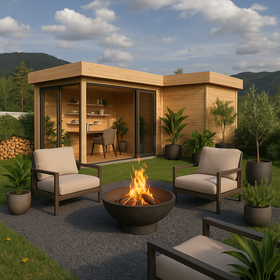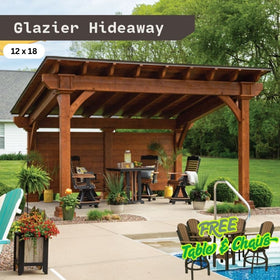512-777-0154

What are the Advantages and Disadvantages of Living in a Tiny House?
Thinking about swapping your big home for a small space that promises freedom and simplicity? Living in a tiny house means saving money, living greener, and embracing minimalism, but it also comes with tight quarters, zoning headaches, and fewer modern comforts.
Let’s break down what are the advantages and disadvantages of living in a tiny house and help you decide if this lifestyle fits your goals, budget, and sense of adventure.
Defining a Tiny House: What Qualifies as "Tiny"?
Before diving into the pros and cons, it helps to know what actually counts as a “tiny house.” These compact homes can take many forms, but they share one big idea: doing more with less space.
1. Size and Legal Qualifications
Size and structure are what make a tiny house truly tiny. Laws and codes define these homes differently from traditional ones.
The International Residential Code (IRC) Definition
According to the International Residential Code (IRC), a tiny house is any dwelling 400 square feet (37 m²) or less, excluding loft space. That’s roughly the size of a two-car garage. This definition helps standardize what qualifies as a safe, livable home within U.S. building rules.
Related: What Are Micro Homes? The Definitive Guide to Size, Legality, and the Tiny Living Movement
Common Construction Types
Tiny homes come in two main varieties.
- Tiny Homes on Wheels (THOW): Built on a trailer chassis, these mobile homes let owners take their living space wherever they go. They’re often classified like RVs and attract travelers or remote workers.
- Foundation-Built Tiny Homes: These are stationary and follow IRC Appendix Q building codes. They’re more permanent, easier to insure, and great for people who prefer to stay rooted in one spot.
2. Core Features and Design
Tiny homes are small but mighty. They’re designed to include everything you need without feeling cramped.
Essential Components
Even the smallest home must have spaces for sleeping, cooking, eating, relaxing, and basic sanitation. Every square foot is used with purpose, turning necessity into creativity.
Space Maximization
Clever design keeps these tiny homes functional. Fold-out tables, stair drawers, loft bedrooms, and compact appliances make tight spaces work smarter. It’s all about turning a limited footprint into something surprisingly livable.
The Advantages and Key Benefits of Tiny Homes
Tiny house living has a lot to offer, especially for people tired of high costs and clutter. Here’s what makes it such an appealing choice.
1. Financial Advantages
One of the biggest reasons people go tiny is financial freedom. It’s a simpler, cheaper way to own a home and live on your own terms.
Significant Cost Savings
Building or buying a tiny home usually costs $30,000 to $60,000, compared to the average U.S. home price of over $270,000. That’s a huge difference and a path toward a life free from massive mortgages.
Many owners use their savings for travel or early retirement instead of endless bills.
Reduced Operating Expenses
Once you move in, the savings keep coming. Smaller homes are easier to heat and cool, lowering your utility bills. You’ll also pay less for property taxes and insurance. Some owners go fully off-grid with solar panels or rainwater systems, cutting costs even further.
2. Lifestyle and Freedom Benefits
Tiny house living isn’t just about money; it’s also about mindset. It changes how you live, what you value, and how much time you spend maintaining your home.
Simplicity and Minimalism
When space is limited, you naturally focus on what matters most. Living small encourages decluttering, intentional choices, and a calmer lifestyle.
Many people say it feels freeing: less stuff, less stress, more life.
Increased Mobility
For those who crave change or travel, a Tiny Home on Wheels offers unbeatable flexibility. You can move your home wherever the next opportunity or sunset takes you.
Ease of Maintenance
With fewer rooms and less space, cleaning and repairs take minutes, not hours. A smaller home means more time to relax, explore, or spend with loved ones instead of managing chores.
The Disadvantages and Negative Realities of Tiny House Living
Tiny houses come with undeniable charm, but they also have challenges that can test even the most minimalist soul.
1. Severe Space Constraints
Living tiny means rethinking space completely. While cozy, it can also feel restrictive.
Limited Storage Capacity
Storage becomes an everyday puzzle. Without closets, basements, or garages, you’ll need to downsize and keep downsizing.
Buying in bulk or keeping extra supplies? Not an option.
Sacrifice of Amenities
Say goodbye to large appliances and luxurious baths.
Most tiny homes rely on compact versions of everything: smaller sinks, two-burner stoves, and showers instead of tubs. It’s all about trade-offs.
Lack of Privacy
Sharing 300 square feet with someone else means constant togetherness. There’s little room to retreat, so it’s important to communicate and stay flexible. Hosting friends can also be tricky without outdoor space.
2. Logistical and Regulatory Hurdles
Even the smallest dream home has to follow the rules. And with tiny houses, that’s often where the headaches start.
Zoning and Legal Issues
Zoning laws vary widely. Some areas don’t allow tiny homes at all, while others limit where they can be placed. Finding legal parking or land can take research and patience.
Plumbing and Essential Services
Many tiny homes rely on self-contained systems like composting toilets, portable water tanks, or solar setups. They’re sustainable but require extra effort to maintain. It’s not as simple as flipping a switch or flushing a standard toilet.
Resale Value and Hidden Costs
While cheap to build, tiny homes can lose value faster than traditional ones, especially THOWs. Plus, expenses like towing, land rent, and hookups add up over time.
Small doesn’t always mean cost-free.
Safety, Durability, and Specialized Uses
Safety and practicality are just as important as cost or style. Let’s look at how tiny homes handle harsh weather and how they’re used in crisis situations.
1. Sturdiness Against Extreme Weather
Tiny houses like GardenHouse24 USA Miriam 44A Classic may look delicate, but when built properly, they can be surprisingly strong and safe.
Protecting Against Winds and Storms
Safety depends on good construction. Using reinforced framing, hurricane ties, and quality materials helps withstand high winds and heavy rain. Container-style or steel-frame builds are especially durable.
Mitigation Strategies
Mobility can actually be a form of protection. If a major storm is coming, you can move your home to safety. Proper insulation and weatherproofing also make a huge difference in comfort and durability.
2. Use in Disaster Relief
Tiny homes aren’t just personal spaces; they can change lives in emergencies, too.
Rapid Deployment and Immediate Shelter
Tiny homes on wheels can be transported quickly, giving disaster victims safe, insulated shelter in days instead of months. They’re faster to deploy than rebuilding traditional homes.
Cost-Effective Temporary Housing
Because they’re small, affordable, and easy to assemble, tiny homes are often used by charities and relief groups. They provide comfort, privacy, and stability during uncertain times.
Making the Decision to Live Tiny
Choosing to live in a tiny house is a big decision packed into a small space. It’s about trading excess for experience, luxury for freedom, and clutter for clarity.
The benefits can be life-changing. But the downsides are just as real.
In the end, the question isn’t whether tiny house living is good or bad. It’s whether it matches what you value most. If you’re ready to live smaller and dream bigger, a tiny house might just be the perfect fit.








